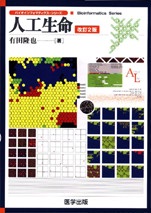 |
Å@
Artificial Life: A Constructive Approach to the Origin/Evolution of Life, Society, and Language Revised New Edition has been just printed out (2002.5) !! 
Takaya Arita Associate Professor, Nagoya University Japanese edition copyright 2003 IGAKU-SHUPPAN, Inc. ISBN4-7578-0102-5 A favorable review by Dr. Toquenaga appears in the current issue of the Artificial Life journal (MIT Press) ! (2001.8)  The Japanese edition has just been published. Reviewed favorably by Hiroki Sayama in IPSJ (Information Processing Society of Japan) Magazine (vol.40, no.11, pp.1157-1158, 1999) 7th on the best-seller list in Japanese Yahoo! The English edition is under preparations. |
| Foreword |
|
|
| Chapter 1: Fundamental Issues |
|
1.1 Introduction (image) 1.2 Philosophy of "Life in the computer" 1.2.1 mind-body problem and life-body problem 1.2.2 Artificial life based on functionalism 1.3 How is life defined? 1.4 What is emergence? 1.4.1 Emergence and artificial life 1.4.2 Criterion of emergence 1.5 Problems |
| Chapter 2: Evolutionary Computation Based on Evolution |
|
2.1 Introduction (image) 2.2 Evolution based on natural selection 2.2.1 Theory of natural selection 2.2.2 Explanation by Dawkins 2.3 Genetic algorithm 2.3.1 Principle 2.3.2 Simple examples 2.3.3 Variation 2.3.4 Fundamental theory 2.4 Other evolutionary algorithms 2.4.1 Evolutionary strategy 2.4.2 Evolutionary programming 2.4.3 Genetic programming 2.4.4 Classifier system 2.5 Experiments on interactions between evolution and learning 2.5.1 Baldwin effect 2.5.2 Experiments by Hinton and Nowlan 2.5.3 Introducing mutation 2.6 Problems |
| Chapter 3: Pioneering Models for Life |
|
3.1 Introduction (image) 3.2 Cellular automaton 3.2.1 Principle 3.2.2 Classification of behavior 3.3 von Neumann's self-reproducing machine 3.4 Langton's self-replicating loop 3.5 Introducing 'death' into self-replicating loop 3.6 Problems |
| Chapter 4: Models for the Origin/Evolution of life |
|
4.1 Introduction (image) 4.2 Digital creature: Tierra 4.2.1 Virtual machine 4.2.2 Execution of programs 4.2.3 Emergence of complex ecology 4.3 Extension of Tierra 4.3.1 Modification of virtual machine 4.3.2 Multi-cell and network 4.3.3 Evolution without progenitor 4.4 Co-Evolution between machines and tapes 4.4.1 Model design 4.4.2 Mutation and stability 4.5 Problems |
| Chapter 5: Models for the Origin/Evolution of Society |
|
5.1 Introduction (image) 5.2 Prisoner's dilemma game 5.2.1 Principle 5.2.2 Cooperation among Tit For Tat 5.2.3 PAVLOV with robustness against noise 5.2.4 GRADUAL with persistent property 5.3 Evolution generating complexity 5.3.1 Emergence of various strategies 5.3.2 Evolution in the model with spatial locality 5.3.3 Evolution of diversity based on symbiosis 5.3.4 Methods for evolution of strategies 5.4 Construction of realistic models 5.4.1 Evolution of complexity and diversity in a 3-player game 5.4.2 N-player Prisoner's dilemma game 5.4.3 Prisoner's dilemma game with choice/refusal 5.4.4 Toward the origin of sociality 5.5 Problems |
| Chapter 6: Models for the Origin/Evolution of language |
|
6.1 Introduction (image) 6.2 Studies at the conventional fields 6.2.1 Controversy over evolution of language 6.2.2 Approach from human language 6.2.3 Approach from animal signaling 6.3 Concept extraction and vocabulary construction 6.3.1 Principle 6.3.2 Model design 6.3.3 Experiments 6.4 Evolution of linguistic diversity 6.4.1 Principle 6.4.2 Model design 6.4.3 Experiments 6.4.4 Discussion 6.4.5 Application 6.5 Evolution of formal grammar 6.5.1 Principle 6.5.2 Model design 6.5.3 Experiments 6.6 Problems |
| Chapter 7: Software Environments for ALIFE Model Construction |
|
7.1 Introduction (image) 7.2 Model construction by using Avida 7.2.1 Comparison with Tierra 7.2.2 Virtual machine 7.2.3 Sample run 7.3 Model construction by using StarLogo 7.3.1 Features 7.3.2 User interface 7.3.3 Sample run 7.4 Programming support by using Swarm 7.4.1 Features 7.4.2 Sample run 7.5 Problems |
| Conclusion |
|
|
| Appendix |
|
Avida: access/install StarLogo: access/install Swarm: access/install |
| References |
|
|
| Index |

|
Å@